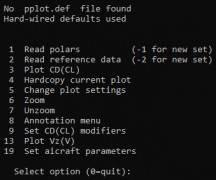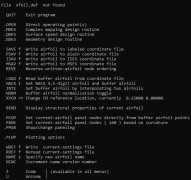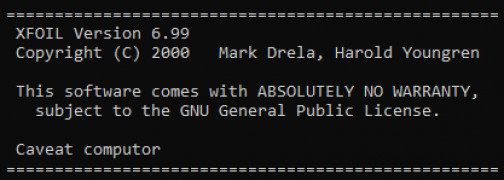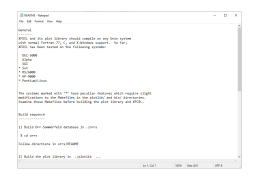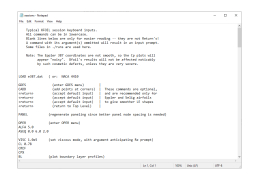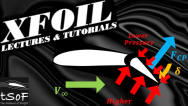
XFOIL
by Mark Drela
XFOIL is a program for the interactive design and analysis of subsonic isolated airfoils.
Operating system: Windows
Publisher: Mark Drela
Release : XFOIL 6.99
Antivirus check: passed
XFOIL is a comprehensive software package for the analysis and design of subsonic isolated airfoils. Developed at the Massachusetts Institute of Technology (MIT) in the late 1970s, XFOIL is used for aerodynamic analysis of two-dimensional airfoils, wings, and complete aircraft. It has become a standard tool for aerodynamicists and is used for aerodynamic drag prediction, lift and moment coefficients, boundary layer characteristics, and more.
XFOIL offers a comprehensive set of features for airfoil analysis and design.
Analysis: XFOIL can be used to analyze an existing airfoil or to design a new one. It can calculate:
• Aerodynamic coefficients (lift and drag coefficients, moment coefficients, etc.)
• Boundary layer characteristics
• Flow field properties
• Transonic effects
• Stall behavior
• Pressure distribution
Design: XFOIL can be used to design an airfoil from scratch. It can generate airfoil shapes using a variety of methods, including:
• Parametric equations
• Modified lifting-line theory
• Inverse design
Optimization: XFOIL can also be used to optimize an existing airfoil or to generate a new design that meets specific performance goals. It offers a variety of optimization algorithms, including genetic algorithms and simulated annealing.
Other features:
• A wide range of flow solvers and input parameters
• User-defined airfoil geometry
• Support for multiple operating points
• Graphing and data-export capabilities
• Integrated plotting and visualization
XFOIL is freely available and easy to use. It runs on Windows, Mac OS X, and Linux platforms and is widely used in academic and industrial settings.
XFOIL provides a comprehensive suite of tools for the analysis and design of airfoils.Features:
XFOIL offers a comprehensive set of features for airfoil analysis and design.
Analysis: XFOIL can be used to analyze an existing airfoil or to design a new one. It can calculate:
• Aerodynamic coefficients (lift and drag coefficients, moment coefficients, etc.)
• Boundary layer characteristics
• Flow field properties
• Transonic effects
• Stall behavior
• Pressure distribution
Design: XFOIL can be used to design an airfoil from scratch. It can generate airfoil shapes using a variety of methods, including:
• Parametric equations
• Modified lifting-line theory
• Inverse design
Optimization: XFOIL can also be used to optimize an existing airfoil or to generate a new design that meets specific performance goals. It offers a variety of optimization algorithms, including genetic algorithms and simulated annealing.
Other features:
• A wide range of flow solvers and input parameters
• User-defined airfoil geometry
• Support for multiple operating points
• Graphing and data-export capabilities
• Integrated plotting and visualization
XFOIL is freely available and easy to use. It runs on Windows, Mac OS X, and Linux platforms and is widely used in academic and industrial settings.
XFOIL requires a PC running Windows XP or later, with at least 512 MB of RAM and a minimum of 60 MB of available hard disk space. It also requires a graphics card with 3D acceleration and support for OpenGL 1.1 or later. Additionally, a mouse or pointing device is recommended.
PROS
Allows comprehensive analysis of aircraft wing sections.
Easy integration with other design software.
Offers accurate predictions of aircraft performance.
Easy integration with other design software.
Offers accurate predictions of aircraft performance.
CONS
Requires a significant understanding of aerodynamics and fluid dynamics principles.
Lacks a user-friendly graphical interface, relies heavily on text commands.
Limited to analysis of two-dimensional airfoil sections only.
Lacks a user-friendly graphical interface, relies heavily on text commands.
Limited to analysis of two-dimensional airfoil sections only.
Nathan Z*****g
XFOIL is a powerful and versatile software for aerodynamics analysis. It is easy to use and has a large range of features. It is great for computing airfoil performance, including lift and drag coefficients, as well as predicting polar curves. Its user interface is intuitive, and the software runs well on a variety of platforms. It has a comprehensive database of airfoils to choose from, and designing your own airfoils is easy. The visualization tools are useful and easy to interpret. XFOIL is an effective and robust tool for many aerodynamic analysis applications.


